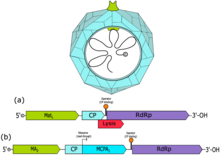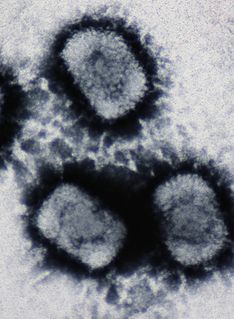
A DNA virus is a virus that has a genome made of deoxyribonucleic acid (DNA) that is replicated by a DNA polymerase. They can be divided between those that have two strands of DNA in their genome, called double-stranded DNA (dsDNA) viruses, and those that have one strand of DNA in their genome, called single-stranded DNA (ssDNA) viruses. dsDNA viruses primarily belong to two realms: Duplodnaviria and Varidnaviria, and ssDNA viruses are almost exclusively assigned to the realm Monodnaviria, which also includes dsDNA viruses. Additionally, many DNA viruses are unassigned to higher taxa. Viruses that have a DNA genome that is replicated through an RNA intermediate by a reverse transcriptase are separately considered reverse transcribing viruses and are assigned to the kingdom Pararnavirae in the realm Riboviria.

Parvoviridae is a family of small, rugged, genetically-compact DNA viruses, known collectively as parvoviruses. There are currently more than 100 species in the family, divided among 23 genera in three subfamilies. Parvoviridae is the sole taxon in the order Quintoviricetes.

Podoviridae is a family of viruses in the order Caudovirales. Bacteria serve as natural hosts. There are currently 132 species in this family, divided among 3 subfamilies and 45 genera. This family is characterized by having very short, noncontractile tails.
Microviridae is a family of bacteriophages with a single-stranded DNA genome. The name of this family is derived from the ancient Greek word μικρός (mikrós), meaning "small". This refers to the size of their genomes, which are among the smallest of the DNA viruses. Enterobacteria, intracellular parasitic bacteria, and spiroplasma serve as natural hosts. There are currently 21 species in this family, divided among six genera and two subfamilies.

Cystovirus is a genus of double-stranded RNA viruses which infects Pseudomonas bacteria. It is the only genus in the family Cystoviridae. The name of the group cysto derives from Greek kystis which means bladder or sack. There are currently seven species in this genus, including the type species Pseudomonas virus phi6.

Nodaviridae is a family of nonenveloped positive-strand RNA viruses. Vertebrates and invertebrates serve as natural hosts. Diseases associated with this family include: viral encephalopathy and retinopathy in fishes.There are nine species in the family divided among two genera.
Tombusviridae is a family of single-stranded positive sense RNA plant viruses. There are currently 76 species in this family, divided among three subfamilies. The name is derived from the type species of the genus Tombusvirus, tomato bushy stunt virus (TBSV).

Viral replication is the formation of biological viruses during the infection process in the target host cells. Viruses must first get into the cell before viral replication can occur. Through the generation of abundant copies of its genome and packaging these copies, the virus continues infecting new hosts. Replication between viruses is greatly varied and depends on the type of genes involved in them. Most DNA viruses assemble in the nucleus while most RNA viruses develop solely in cytoplasm.

Φ6 is the best-studied bacteriophage of the virus family Cystoviridae. It infects Pseudomonas bacteria. It has a three-part, segmented, double-stranded RNA genome, totalling ~13.5 kb in length. Φ6 and its relatives have a lipid membrane around their nucleocapsid, a rare trait among bacteriophages. It is a lytic phage, though under certain circumstances has been observed to display a delay in lysis which may be described as a "carrier state".
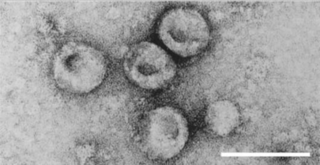
Pestivirus is a genus of viruses, in the family Flaviviridae. Viruses in the genus Pestivirus infect mammals, including members of the family Bovidae and the family Suidae. Currently, 11 species are placed in this genus, including the type species Pestivirus A. Diseases associated with this genus include: hemorrhagic syndromes, abortion, and fatal mucosal disease.
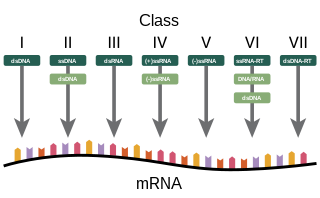
Baltimore classification is a system used to classify viruses based on their manner of messenger RNA (mRNA) synthesis. By organizing viruses based on their manner of mRNA production, it is possible to study viruses that behave similarly as a distinct group. Seven Baltimore groups are described that take into consideration whether the viral genome is made of deoxyribonucleic acid (DNA) or ribonucleic acid (RNA), whether the genome is single- or double-stranded, and whether the sense of a single-stranded RNA genome is positive or negative.

Tectiviridae is a family of viruses with seven species in three genera. Bacteria serve as natural hosts. Tectiviruses have no head-tail structure, but are capable of producing tail-like tubes of ~ 60×10 nm upon adsorption or after chloroform treatment. The name is derived from Latin tectus.

Double-stranded RNA viruses are a polyphyletic group of viruses that have double-stranded genomes made of ribonucleic acid. The double-stranded genome is used to transcribe a positive-strand RNA by the viral RNA-dependent RNA polymerase (RdRp). The positive-strand RNA may be used as messenger RNA (mRNA) which can be translated into viral proteins by the host cell's ribosomes. The positive-strand RNA can also be replicated by the RdRp to create a new double-stranded viral genome.

Escherichia virus Qβ is a positive-strand RNA virus which infects bacteria that have F-pili, most commonly Escherichia coli. Its linear genome is packaged into an icosahedral capsid with a diameter of 28 nm. Bacteriophage Qβ enters its host cell after binding to the side of the F-pilus.
Enquatrovirus is a genus of bacteriophages in the order Caudovirales, in the family Podoviridae. Bacteria serve as natural hosts. There is currently only one species in this genus: the type species Escherichia virus N4.
Plectrovirus is a genus of viruses, in the family Plectroviridae. Bacteria in the phylum Tenericutes serve as natural hosts, making these viruses bacteriophages. The type species Acholeplasma virus L51 is the only recognized species in the genus.

Virgaviridae is a family of positive-strand RNA viruses. Plants serve as natural hosts. The name of the family is derived from the Latin word virga (rod), as all viruses in this family are rod-shaped. There are currently 59 species in this family, divided among seven genera.
Tevenvirinae is a subfamily of viruses in the order Caudovirales, in the family Myoviridae. Bacteria and archaea serve as natural hosts. There are currently 77 species in this subfamily, most included in 11 genera.

Allolevivirus is a genus of positive-strand RNA viruses, in the family Leviviridae. Enterobacteria serve as natural hosts. There are currently only two species in this genus including the type species Escherichia virus Qbeta.
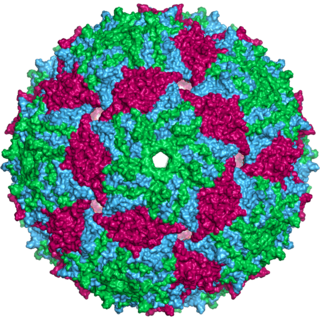
Levivirus is a genus of positive-strand RNA viruses, in the family Leviviridae. Enterobacteria serve as natural hosts. There are currently only two species in this genus including the type species Escherichia virus MS2.
